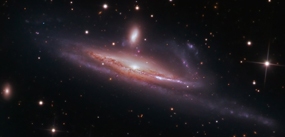Syllabus
AST 358
"Galaxies and the Universe"
Spring 2011
Professor Gregory A. Shields
TTh 2 p.m. in RLM 15.216B
Unique No. 48310
Course Description
This course presents modern observations and theories of the structure and evolution of the universe. We trace the evolution of the universe from the first moment through the creation of the primeval fireball radiation and the birth and evolution of galaxies. We study the Milky Way, external galaxies, quasars and their giant black holes, the expanding universe, dark matter, dark energy, and the Big Bang. We will emphasize the use of physical laws in a quantitative way to interpret observations and construct theoretical models of galaxies and the universe.
This course is intended for astronomy majors and other science and engineering majors with a strong background in undergraduate math and physics, including mechanics, electricity and magnetism, differential and integral calculus, and vector calculus.
Prerequisite. Physics 316 (Electricity and Magnetism) or equivalent; AST 352K or AST 307 is recommended.
Instructor. Professor Gregory Shields. Office: RLM 15.224. Phone: 471-1402. E-mail: shieldsga@mail.utexas.edu. Office Hours (subject to change): To be announced. Web page: https://www.as.utexas.edu/~shields/shields.html
Teaching Assistant. To be announced
Grading. Course grade will be based on two exams in class, term paper and presentation, and homework. Exams will be closed book involving numerical problems and essay questions. Exams will cover lectures, assigned reading, and homework. Exam weights and (tentative) dates are:
|
First Exam |
25% |
To be announced |
|
Second exam |
30% |
To be announced |
Homework will count 30%. Term paper and presentation will count 15%.
Textbook. Peter Schneider, "Extragalactic Astronomy and Cosmology", Springer Verlag (2006), ISBN -13 978-3-540-33174-2 (required).
Help session. To be announced.
Astronomy Department Policies. See "Memo to Undergraduate Astronomy Students Regarding Astronomy Courses" (http://outreach.as.utexas.edu/students/memo.html).
Star Parties. The Department has observing sessions Wednesday evenings on the roof of RLM and Friday and Saturday at Painter Hall (http://outreach.as.utexas.edu/public). You can use the 9-inch yourself if you are checked out on it. McDonald Observatory in west Texas also has public programs (http://mcdonaldobservatory.org/visitors; phone 471-5285).
Drop Dates. March 28 is the last day to change to or from the credit/no credit basis. After March 28, you may drop a course or withdraw from the University only for urgent and substantiated, nonacademic reasons. Please consult the University's published calendar (http://registrar.utexas.edu/calendars) for verification and further information.
About the Instructor. Professor Shields was born in Los Angeles, California and grew up in Nebraska and Kansas. He earned a B.S. in Physics from Stanford University in 1968 and a Ph.D. in Astronomy from Caltech in 1973. Following a postdoctoral fellowship at Harvard, he joined the UT faculty in 1974. He now holds the title of The Jane and Roland Blumberg Centennial Professor in Astronomy, and served as Chairman of the Department of Astronomy from 1990 to 1994. He has taught both graduate and undergraduate courses throughout his career at UT. His research interests include studies of ionized nebulae in galaxies and the nature of quasars and their central black holes. He has published numerous research papers and popular articles.
Background needed. AST 358 is one of several upper division courses required for Astronomy majors. The level of the course is aimed at giving a good foundation for success in graduate school. The prerequisite for this course is Physics 316 "Electricity and Magnetism". There is no formal Astronomy course prerequisite for AST 358, but many students will have had AST 307 "Introductory Astronomy" or AST 352K "Stellar Astronomy". In order to be competitive in AST 358, students who have had no previous course in astronomy will need to study some basic background material by the second week of the semester. Reading resources will be made available, and students will be asked to work a set of homework problems designed to acquire and demonstrate knowledge of the essential background topics. This will allow us to move quickly into the main subject material of the course. Important topics include Newtonian gravitation and orbital motion, spectra and radiation laws (Wien's law and the Stefan-Boltzmann law), basic properties of stars, stellar evolution, and the H-R diagram. The first few lectures will review these topics.
Suggested Introductory Textbooks
Some of these texts are available at the UT Libraries or may be borrowed from the instructor. Any standard descriptive introduction to astronomy should be helpful. Editions dated around 2005 or later should be adequate for background purposes.
J. Bennett et al., "The Cosmic Perspective", any edition including stars and galaxies.
E. Chaisson and S. McMillan, "Astronomy: A Beginner's Guide to The Universe," Prentice Hall. By the same authors, Astronomy Today, Volume II Stars and Galaxies.
M. Seeds, "Stars and Galaxies", Brooks Cole. This is a version of Seed's introductory astronomy textbook Horizons: Exploring the Universe omitting detailed discussion of the solar system.
Many useful tutorials on topics in astronomy can be found on the World Wide Web.
Higher Level Textbooks
Dale Ostlie & Bradley Carroll, "An Introduction to Modern Stellar Astrophysics", Addison Wesley (1996), ISBN 0-201-59880-9. A more inclusive version, Carroll & Ostlie "An Introduction to Modern Astrophysics," contains material on galaxies and the universe.
Linda Sparke & John Gallagher, "Galaxies in the Universe", Cambridge (2007). An introduction to galaxies, with less discussion of cosmology than in Schneider.
Francis LeBlanc, "An Introduction to Stellar Astrophysics", Wiley (2010). Text used in AST 352K in Fall 2010.
